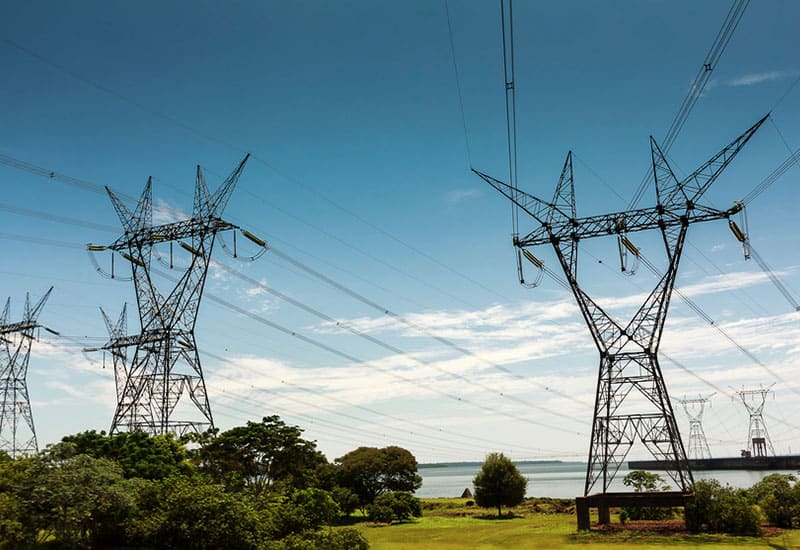While necessary for modern life, power lines can pose a significant danger to people and animals. For this reason, it is essential to consider the potential hazards associated with these structures when operating in their vicinity.
Electricity is transmitted through power lines via high voltage currents that can cause severe injury or death when too close. The range of the electric field depends on the voltage carried by the line and the distance from it. The current running through a single conductor of an overhead power line can be up to 600 kilovolts (kV). That’s because of lethal electric shock, even at moderate distances. A minimum clearance of three meters should be respected around live overhead lines, as contact with them can lead to electrocution.

The danger posed by power lines doesn’t end with electrical shock—they also create fire hazards due to arcing caused by birds nesting on or flying into contact with them, as well as from nearby trees and branches coming into contact during strong winds or storms. Such fires are hazardous near buildings or flammable materials such as dry grasses and brush, and they can quickly spread out of control in dry conditions.
Animals, too, can suffer harm from power lines and related infrastructure. Birds are particularly vulnerable due to their unfortunate habit of perching atop high-voltage conductors, often resulting in electrocution. Measures like mounting protective shields onto wires can help reduce this hazard. However, caution should still be taken, given the animal’s tenanimal’sr inquisitiveness and potential lack of knowledge regarding this risk.
Electromagnetic fields (EMFs) generated by power cables may harm humans and wildlife over extended periods. These EMFs have been linked to an increased risk of cancer among people potentially exposed over long-term intervals and interference with bird migration patterns in certain species that rely upon Earth’s magnEarth’seld for navigation in their journeys across vast distances yearly. As such, extra caution should be exercised when living or working near electrical infrastructure if prolonged exposure is expected.
To ensure safety around power lines, all individuals must exercise caution when working near them—including being aware of any local regulations governing their use—and keep clear from naked wires and other components where possible. Where access cannot be avoided, always use appropriately grounded insulated equipment and ensure that no metal objects come into contact with them, including ladders used for work at higher altitudes. In addition, livestock owners should ensure that fences surrounding grazing areas remain far from active electrical infrastructure. Proper upkeep of surrounding vegetation will also help reduce risks associated with contact between foliage and overhead wires. Finally, stay alert for signs indicating maintenance activity on transmission lines so you know beforehand when construction crews will likely be active onsite.
How Much do Power Lines Decrease Property Value?
Power lines decrease property value by 5% on average. Properties near power lines sell for less, usually from 2% to 9%. Scientists showed that children living in homes as far as 600 m from power lines had an elevated risk of leukemia.
Power lines in a landscape can hurt the value of a piece of real estate, though it is difficult to gauge precisely how much. The impact depends mainly on various factors, including the visual appearance of the power lines, their proximity to the property in question, and local zoning regulations.
In terms of visual appearance, noticeably large or ugly-looking power lines tend to have an even more negative impact on property values than smaller ones located further away from sight. For example, suppose large metal lattices are looming right outside a house attached to its exterior walls. That tends to cause potential buyers to turn away because it can be perceived as unattractive or unsightly. Similarly, if the wires are placed high up and parallel with a home’s roof, this too can detract from its aesthetic appeal and thus deter buyers who may view it as unappealing or threatening.
Another factor affecting how much power lines decrease property value is their proximity to the home. If they are close by and visible from every angle, they will have a more significant negative impact than if they are located at some distance from sight. However, even if the power lines are far enough away not to be seen but still within close range, this could significantly diminish the worth of any affected properties due to heightened safety concerns about radiation emissions or other electrical hazards (though such fears are often unfounded).
The final key consideration is local zoning regulations. Certain municipalities may have ordinances that limit where developers can build and erect power lines relative to existing residential areas—in which case, this could provide some measure of protection for homeowners living nearby as far as their property values go. Other jurisdictions might not have any such laws at all—or they might offer incentives for placing them in certain areas because doing so would enable them to meet electricity demand more efficiently or cost-effectively—resulting in higher depreciation levels for those homes nearby.
To learn more about How to Calculate Land Value, you need to analyze our articles :
- Does Rezoning Increase Property Value?
- Does Clearing Land Increase Property Value?
- Does a Barn Increase Property Value?
- Do Fences Raise the Property Value?
- How much does a shed add to property value?
- How Much Does an ADU Increase Property Value?
- How Much Does a Guest House Increase Property Value?
- Does a New Roof Increase Property Value?
- How Does Subsidence Affect Property Value?
- How Much do Power Lines Decrease Property Value?
All told, then, it is hard to predict precisely how much any given set of power lines will affect property values in any given location because there are so many variables involved that need to be taken into account when making an assessment (e.g., size/type/style/location/zoning regulations). That being said. However, research has indicated that homes located near aboveground transmission towers typically depreciate by 7-11 percent compared with those without nearby buildings—and while this isn’t necessarily representative of all properties impacted by power lines one way or another, it does provide some indication into how much their presence can potentially detract from overall worth over time.
